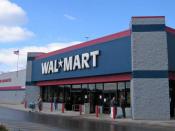I. CURRENT SITUATION
A. CURRENT PERFORMANCE
Wal-Mart is the world's number 1 retailer, with more than 4,800 stores, including 1,475 discount stores, 1,750 combination discount and grocery stores (Wal-Mart Supercenters in the US and ASDA in the UK) and 540 warehouse stores (SAM's Club).
Nearly 75% of its stores are in the US, but Wal-Mart is expanding internationally. Wal-Mart is the number 1 retail in Canada and Mexico. The company also owns nearly 38% of Japanese supermarket chain SEIYU.
Wal-Mart generated a solid performance for the fiscal year 2004 ended January 31th. Here are some important numbers:
ÃÂ Net sales increased from 229.6 billion to 256.3 billion (+ 11.6%).
ÃÂ Total asset increase 10.7% to 104.9 billion.
ÃÂ When compared to fiscal year 2003, Wal-Mart stores segment experience a 9.1% increase in operating profit and a 10.9% increase in sales in fiscal year 2004
ÃÂ Domestic expansion resulted from the addition of 139 new discount stores, Supercenters and Neighborhood markets, as well as 130 conversion and/or relocation from Discount stores to Supecenters.
ÃÂ Internationally, Wal-Mart added 83 units net of clothings. Worldwide square footage increased approximately 46 million per square or *%.
B. STRATEGIC POSTURE
1. Mission
Wal-Mart mission statement is:
"To give ordinary folk the chance to buy the same thing as rich people."
Sam Walton built Wal-Mart on the revolutionary philosophies of excellence on the workplace, customer service and always having the lowest price. The 3 basic beliefs of the company are:
1) Respect for the individual
2) Service to our customers
3) Strive for excellence
Wal-Mart strives to always do the right things in the right way. The company does not accept the notion that business as usual is ever appropriate, and Wal-Mart mission is to ensure that constant change remains a vital part of the...


